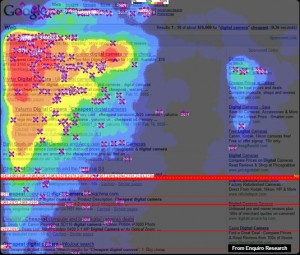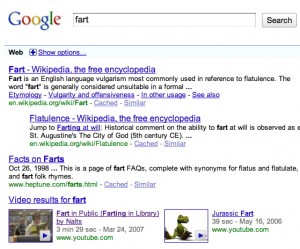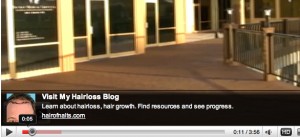Getting Your Video to Top of Google Ranking (fart)
I met recently with Steve Rubel, who Business Week once called “the all-knowing thumper in a forrest of bambinos.” He’s dumped his Micropersuasion, but still posts on SteveRubel.com.
Steve asked me what I knew about video and SEO, and prompted this succinct 101-post on “how to use online-video to crawl your way to the top of Google rankings.” As I’ve reminded you before, YouTube is the second most important search engine, and YouTube videos get a strong advantage on Google. When you search a term, and see a video thumbnail someone’s done their homework.
Mark Robertson is the authoritative voice on video SEO, and his blog (ReelSEO) is a must-read. His post “SEO for Video” is essential reading.
I’m less savvy than Mark or other SEO/SEM experts, but I am a marketer who spends many waking hours trying to get my YouTube videos more views. Here’s ReelSEO’s Jeremy Scott’s piece about my previous “inside” scoops on YouTube and search (and his clever retort of my assertion that online-video will trump social media).
Sure you can buy text ads surrounding these Google searches, but they will burn through a budget fas. Furthermore, searchers usually jump to the “organic” or “natural” results that aren’t in yellow. Google eye-tracking charts have proven that, and undisclosed eye-charts of YouTube show that the primary navigation attracts eyes to that coveted search field. I’m not suggesting “either/or.” You want to appear for key searches anyway you can… even if you’re buying ads on searches that you already organically dominate. I have fought this logic, but the text ads for your brand name usually yield the highest-quality traffic (even if they MIGHT have found you without the ads).

Now some fresh tips and secrets for helping your video content rise on Google results, where you are exponentially more likely to be discovered by curious prospects.
1) Put Your Video in Places Easy for Search ‘Spiders” to Find. Your video content is either on YouTube or it’s hiding. Google’s automatic “spiders” dig routinely through your site, but don’t make them work too hard. If you have videos streaming on Quicktime on your website, then don’t expect them to get discovered easily (especially if they’re buried deep). Start posting on YouTube, then use TubeMogul to go more broadly (a free tool that distributes videos to dozens of existing online-video accounts, as long as you have accounts on them). I have asked TubeMogul’s CEO (Brett Wilson) to allow video publishers to vary keyword tags by site; currently you tag your video the same for all sites, which doesn’t allow you to experiment and hedge bets. That will increase odds of “Mother Google” blessing you with first-page result for niche terms. Again, if your video is on your brand site it might as well be in a file cabinet.
2) Oddly, Metadata Still Works. Metadata includes the title, description and keywords that search engines can use to find your content. Be selective, and go for targeted terms. Don’t try “digital camera,” but something more narrow like “how to buy cheap video cameras.” Then be consistent with your title, first words of your description, and the keywords. This can be challenging, because viewers like short irresistible titles… but spiders will index based on common search terms or phrases.
3) Engagement Matters. A well-viewed, top rated, commented, favorited video is going to work MUCH better than one you post solo. That’s why the YouTube stars (already popular amateurs or pros) have an edge on the rest. Their active fan following moves them to top of most-viewed videos, and makes them easy for a new audience to discover them. This is one of the reasons I urge marketers to tap into the credible platform of a weblebrity instead of posting their own videos. If I upload a video on my “Nalts” channel, it’s going to do better on SEO than the same exact video posted to a new account or your account. Many people attempt to replicate this by asking friends and family to “5 star, favorite, and comment.” But a few dozen people aren’t as powerful as the thousands of active fans that rate their favorite creators 5 stars even before watching the full video.
4) YouTube is Getting Smarter about weeding out videos boasting provocative thumbnails (the images that represent the video on YouTube or Google search results). So in time, pictures of neon graphics (a hot trend) and boobies (a timeless certainty) will not outrank relevancy. Ultimately I expect YouTube to rank videos based, in part, on “attention scores.” As a YouTube Partner I know which of my videos have high “attention scores,” which is a relative score based on videos that are of similar duration. I can’t tell precisely how many people stopped watching at a specific moment (or the average view duration) but I can see where most people dropped, and I try to manage that by “teasing” video that comes later. If a video for a particular term has a high “attention score,” then Google/YouTube can correctly assume it was relevant to the searcher. So I’d expect that to be as vital as transcribed text, and Google/YouTube already has the ability to connect these (and may well be using them).
5) While Waiting for Transcription. Don’t hold your breath for Google to transcribe videos, which will be the Holy Grail. Rubel observed that “Google Voice” is teaching Google to recognize various dialects, and that will come in handy when it’s time to transcribe and index video speech for word searches. In the meantime, you want your videos to be valuable/relevant and short (30-90 seconds), then compel action (like a visit to a website) with a meaningful promise. Remember it’s much easier to get a YouTube viewer to a channel page than to abandon YouTube. We’re still seeing click-thru rates (from YouTube to brand sites) in the low single digits. Some YouTube creators (like “CharlesTrippy” and “Shaycarl“) post daily videos as long as 10-12 minutes, which automatically propel them to the most popular page. This may give them an advantage, and I recently speculated that long videos may, counter intuitively, be a view driver. I’m now thinking that the frequency keeps them “top of mind” and forges a bond with their viewers, which is the real driver. Still, their fans will watch more of those videos than typical videos of that duration… and that certainly should help. While we wait for transcribed search, consider captioning your content (it’s time consuming but free on various sites) or adding a full or partial text transcript to your description.
5) The basics of SEO apply when it comes to keywords. Spell hot ones wrong on purpose, focus on less competitive terms/phrases, and use desired ones first. Before Google stopped using metatags to rank, it always put exponential emphasis on the first word than the fifth. So consider carefully the first words you’ll use in sequence, and don’t try to fight for highly competitive terms. I used to automatically use “Nalts” as a keyword, but now I place that at the end of my list. Sometimes I’ll use a partial phrase like “how, to, become, popular, on, youtube,” and name the video similarly. Then my description will begin with “How to become popular on YouTube…”
6) I haven’t seen evidence that YouTube videos embedded on other sites have an advantage. Logically, an embedded video means bloggers and other websites find the content valuable… and YouTube videos used to show publicly (under video you’ll see “statistics and data” the sites that drove traffic to a video, but have inexplicably eliminated that somewhat recently). It was probably being abused by spammers. Google tends to focus on relevancy rather than monetization, but it’s hard to ignore a motivator YouTube has: the site can monetize videos on its own site easier than on other sites. So it’s in Google’s financial interest to reward video content that draws traffic to YouTube rather than embedded videos on sites that use its bandwidth without creating a premium for advertisers. We know that if hundreds of websites link to President George Bush using a hyperlink called “stupid,” then he’ll rise on search results for the word stupid. So perhaps my top ranking for the keyword “fart” was helped by any sites that linked to me with the tag, “fart video.”
But there’s a true relevancy factor at play. If you’re inclined to search “fart,” I’m guessing a video of a kid with a fart machine is one of the things you may be hoping to find. Or maybe you were seeking a nice medical definition or the origin of the word (Wikipedia, which now has trumped me, indicates “immediate roots are in the Middle English words ferten,feortan or farten; which is akin to the Old High German word ferzan. Cognates are found in old Norse, Slavic and also Greek and Sanskrit.”
7) Timing. Michael Buckley’s “What The Buck” show and Sxephil’s vlogs benefit greatly from their regular content about topics being searched. Their recent videos are often between 500K to a million, and they have some videos that are cash cows for certain subjects (garnering regular views that are in the multi-millions). As I write, they’re no doubt making a video about the Golden Globes, knowing that on Tuesday people will return to work, and be grazing for recaps. This timely content also serves as “link bait” to popular social-media sites that are looking for current videos about hot content. Topicality is important, and the best personal example I can provide is my 2009 Superbowl “best commercials” video. It maintains a poor attention score (lots of early drops relative to most of my videos), but I launched it before last year’s Superbowl game… fetching it 3-4 million views in the days after last February’s game… and it’s up to 7 million now. The GoDaddy boob thumbnail doesn’t hurt either, but that’s not helping the attention score. If you want boobies, you’re turned off to see a dad and his kid talking about the best ads. If I did a daily vlog about the hot terms I found on Yahoo Buzz, I’m quite certain I could dramatically expand my daily views from 150K-200K to 500K. But alas I have neither the time nor interest. I’m guessing Buckley and Phil scour many sites to find out what content people are searching each day.
8) Untapped Secret: SEM on YouTube. I almost hate to give this away. But if you have an Adsense/Adwords account and you’re a YouTube partner, you can advertise your video based on keyword terms. This drives search-driven ads that display your video to a targeted audience, and is not expensive for most terms (a cost-per-click bid of a few pennies sometimes works). Even better, you’re then able to put your own simple “InVideo” ad over the video with a clickable hyperlink. See the example on my “Hair Transplant Fun,” which is more likely to drive viewers to my blog than a hyperlink in the description. And remember: get that hyperlink early in the description so it appears to viewers in a truncated description.
Now a few things that don’t work, or at least will die soon enough.
- I’m finding lots of spam automatic blogs that are now embedding my videos and descriptions hoping to trick Google into indexing it. This annoying technique is also fooling Radian6 and other social-media monitoring tools, which report this old content as new. Last week I tried a “Nalts” search on Radian6 and was frustrated to see old video descriptions appearing as recent buzz about me. Maddening.
- I’m also constantly finding my name packed with other YouTube usernames in videos by people who naively hope that works. Puh-leeze. Did that ever work? It’s a good technique if you’re mentioning a particular YouTuber, because we do tend to “ego surf” for content that tags our name. But as soon as I see 12 other names aside mine, I know it’s trolling.
- Fake thumbnails might artificially drive views, but the video will be penalized when the attention scores show Google the video duped its users.



Google rankings always confuse me, especially my google image results. I am still trying to fix those. I mean, the top one was me with a fake mustache for like 6 months, and pretty much 90% of the other images are Danny Devito, LolDogz, or pictures of strange things from WWFF or from PeterCoffin’s website, which I fully don’t understand. Recently they’ve been improving, but I will never understand the rhyme or reason behind what goes on there.
and as for google website results, my Youtube channel still isn’t even listed in the first 20 pages of results for “Reubnick”. That is irritating.
Nalts – Thanks for the in-depth article and of course, for the mention… Paaarrphh (that’s my fart noise)
Great article, if it’s any interest to you you are actually the very first result form Google for the keyword fart. (google.co.uk), what a strange yet nice achievement.
Too many words. Not enough that I care about.
Here is a joke a priest just emailed me.
I was in the restaurant yesterday when I suddenly realized I desperately needed to pass gas.. The music was really, really loud, so I timed my gas with the beat of the music..
After a couple of songs, I started to feel better. I finished my coffee, and noticed that everybody was staring at me….
Then I suddenly remembered that I was listening to my iPod.
I see you are still using “exponentially” to mean “a whole lot” (actually, I think you used “an ass load” last time I pointed out your abuse of the term).
When comparing two things, to say that one is exponentially more than another is pretty meaningless mathematically.
I could say you are exponentially older than I since YourAge = MyAge^1.206 (where age is given in years), but it really doesn’t make much sense to do so.
It does make sense to talk about exponential GROWTH. (Think compounding interest or the US national debt.)
Sorry. I had to get that out of my system even though I know it probably won’t make a difference.
Kevin – the stuff for the book goes in a word doc the junk goes on the blog
Heres a link to the ultimate farting machine:http://www.ebaumsworld.com/soundboards/play/658 ……yw,dont mention it,enjoy!
EXCELLENT EXCELLENT article. You are RIGHT on the money and took the time to really lay it all out in detail. Great job! Video can work amazing wonders done properly (can work great even if not done properly, but do it right and you can really get amazing results).
Great article in a sea of unfresh marketing tips.